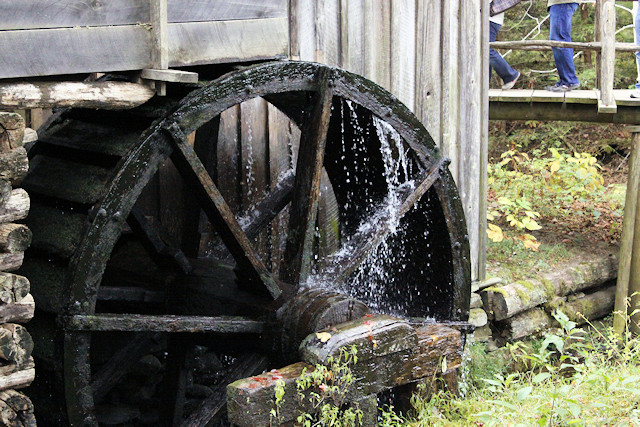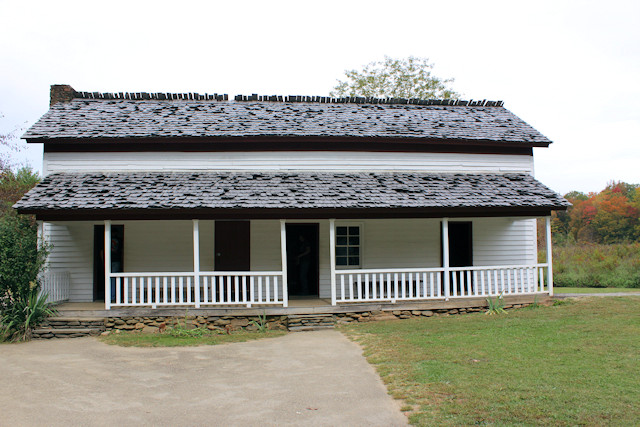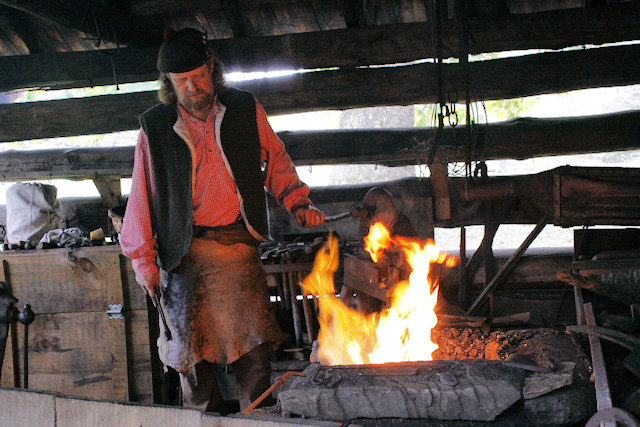Cable Mill

The Cable Mill Water Wheel in Cades Cove.
Cable Mill is one of the most popular stops on the Cades Cove tour. Along with all of its historic structures, it is also home to a visitor center and public restrooms. The visitor center is open from mid-April until the end of October each year. All the buildings in the Cable Mill area (with the exception of the actual mill itself) were actually moved from their original locations and relocated here.
John P. Cable Mill
It was not uncommon for entire villages and towns to be built around grist mills in the 1800s. Because of their ability to grind grains into flour or meal at a faster rate than famers could do it themselves, grist mills were vital to local economies. As a result, the town mill often became a social gathering place as well, fostering friendships, business relationships, and sometimes even young courtships.
John P. Cable built his grist mill in Cades Cover in the early 1870s. He was a descendent of Peter Cable, a Pennsylvania Dutch farmer who had arrived in the area in the 1820s and designed an elaborate system to drain the swampy lands located in the western part of the cove.
John Cable was the only person in Cades Cove to use an overshot water wheel, a gravity wheel which harnesses the force of gravity acting vertically on the water as it travels from the top to the bottom of the wheel. Cable Mill’s power was supplied by Mill Creek, although a connecting channel was dug to Forge Creek so the mill could tap both streams when water levels were low.
Cable Mill took double advantage of its waterwheel by using it to power saw mills as well. This revolutionized the way homes were built in the cove, as people switched from using logs to lumber and frame construction. The Gregg Cable house still stands as an example of a frame built house in Cades Cove.
Sorghum Mill
Maple syrup, honey, and maple sugar were all natural sweeteners used by settlers in the Smoky Mountains. Molasses made at the Sorghum Mill, however, offered a special treat. The process of producing molasses began by stripping the leaves from the stalks of sorghum cane. The stalks were then fed between the rollers of the mill.
Harnesses worn by farm animals such as oxen, mules, or horses were attached to the mill’s long poles. This attachment forced the animals to walk in a circle, which turned the rollers and pulled the stalks further into the mill, causing the sorghum juice to be squeezed out. The collected juice was then boiled down in an outdoor furnace until it became thick and dark molasses. The Cades Cove visitor center still offers molasses for sale from around the middle of September into October each year.

Becky Cable Home in Cades Cove.
Gregg-Cable House
Built in 1879 on a one-acre tract of land by Leason Gregg, the Gregg-Cable House was the first frame built house in Cades Cove. Gregg actually purchased the land and the lumber for the house from John P. Cable, whose son, Dan, and daughter, Rebecca (“Becky”), would eventually purchase the house back into the Cable family.
It was originally located at the first ford of Mill Creek on Forge Creek Road, and Gregg operated a general store on the first floor. Becky Cable would later use the home as a boarding house. Following her death in 1940 at the age of 94, the house was moved to the Cable Mill area.
Cable Mill Cantilever Barn
Not every barn in Cades Cove featured the cantilever design, but the barn at Cable Mill stands as a lasting example of the architectural style. While most Smoky Mountain barns featured the familiar design scheme of a row of stalls on each side of an isle, the cantilever design consisted of stalls situated in the middle of the structure, with a large loft overhang on both sides.
The huge eaves provided shelter for farm equipment and for animals that were not kept in the stalls, and the large overhanging loft above provided extra storage space. Cantilever barns were not totally without their disadvantages, however, as their lack of outside walls and sturdy stalls could sometimes leave domestic animals susceptible to attacks from Smoky Mountain predators.
Corn Crib
Both settlers and their animals in Cades Cove were heavily dependent on corn, making the corn crib a vital structure on the farm. Corn cribs in Cades Cove were designed with slats which would hold the corn in while still allowing maximum air circulation. Harvested corn ears were usually tossed into the crib through an above hatch with the shucks still on.
Once the corn air-dried into hard kernels on the cob, it could be retrieved through a small door at the bottom of the crib. The ears were then shucked and rubbed together to knock the hardened kernels from the cob. Once off the cob, the corn could then be used to make everything from hominy grits to chicken and livestock feed. The Cades Cove area still features several of these corn cribs for visitors to observe.
Smokehouse
Families in Cades Cove would always welcome freshly killed bear, deer, or turkey come mealtime, but the difficulty in preserving these types of meat made them an occasional treat rather than a staple of early settlers’ diets. For the most part, pork was favored over meat. Pork could be smoked over a slow fire and then cured with salt and other spices to preserve it. Ham, bacon, jowl, and sausage were all kept in meat houses. Several examples of early smokehouses can still be seen today throughout Cades Cove.

The Blacksmith at the shop at Cable Mill in Cades Cove.
Blacksmith Shop
Once visitors to Cades Cover pass the visitor center, the first building they will see is the blacksmith’s shop. When James V. Cable inherited the mill and farm from his father, John P. Cable, he decided to also become a blacksmith.
This was perhaps in response to the constant need for the metal shoes used by mules and horses in their farm work. Since farmers were bringing their products to the mill, it became a matter of convenience to to simply have their animals shoed there as well. In addition to shoeing farm animals, the blacksmith fashioned other metal products for the farm, home, or light industry, including hammers, axes, chains, knives, hoes, and hinges.
Next Stop: Henry Whitehead Place
